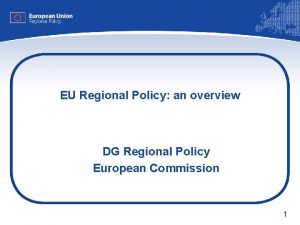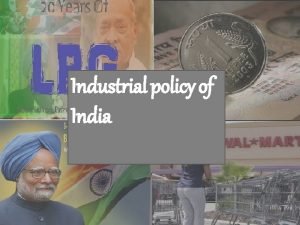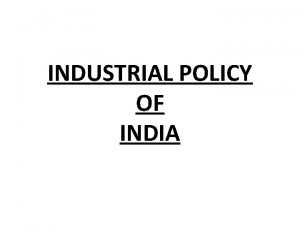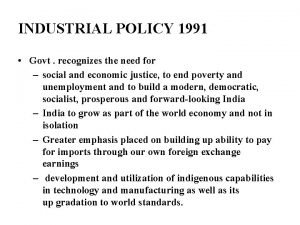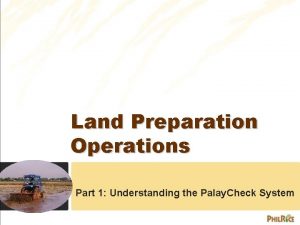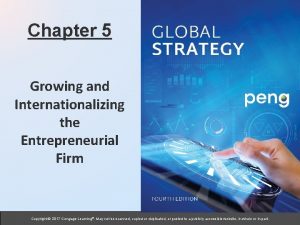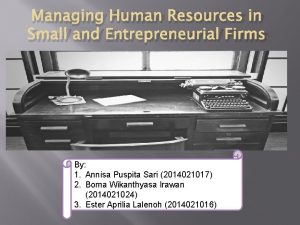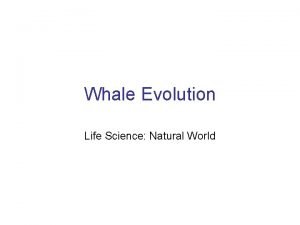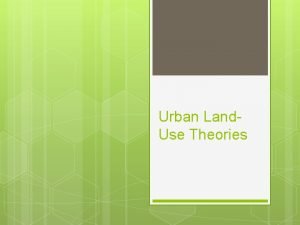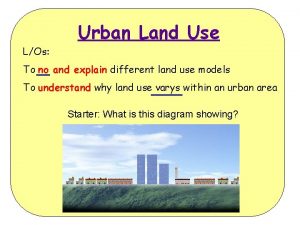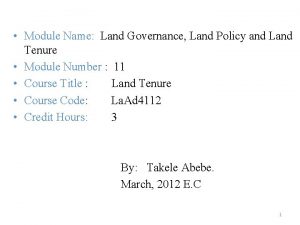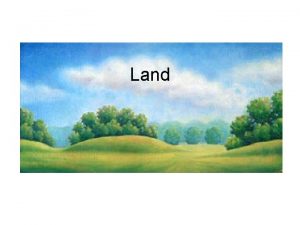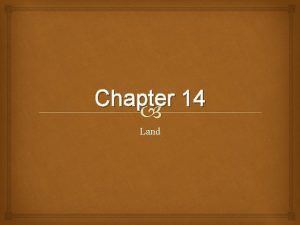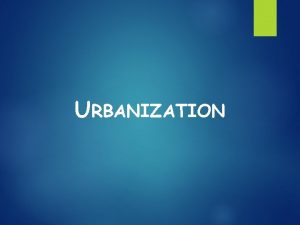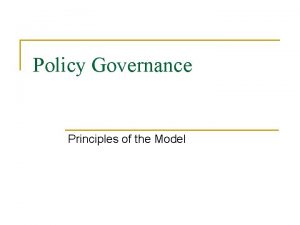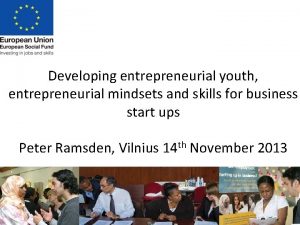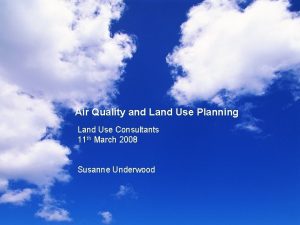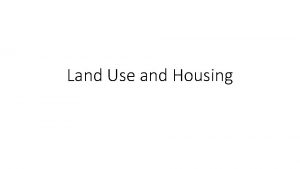Industrial Land Use Policy and Entrepreneurial Regional Governance





















- Slides: 21

Industrial Land Use Policy and Entrepreneurial Regional Governance in Pei-Kee Metro Triangle – An Schumpeterian Exploration in the Context of Greater China Intercity Network Cassidy I-Chih Lan (藍逸之) Kowloon Tong, HKSAR Dec 14, 2007

Outline (大綱) • Introduction • Entrepreneurial city as a geographical competitor seeking for multi-scalar articulation • The industrial land use system and the restructuring of industrial space in Pei-Kee Metro Triangle • Restructuring the industrial land redevelopment in PPKMT – towards a Schumpeterian entrepreneurial regional governance • Concluding remarks

1. Introduction • Globalization – urban industrial restructuring – Regenerating industrial space • Entrepreneurial city → an important measure – To respond the geographic dynamics of spatial division of labor – To create clear urban positioning – To layout pragmatic and innovative strategies – To construct strong time-space articulation to other spatial scales

• Schumpeterian approach of entrepreneurial Jessop and Sum (2000) city – the redevelopment institution of industrial land use in ‘Greater Taipei metropolitan area’ – (Pei-Kee metro triangle, PPKMT or PPK) • Urban competition within Greater China intercity network – Land vacancy vs. innovative industrial corridors ? The urban-regional experience offers us an in-depth observation to examine the renovation of old industrial zones and the governance dilemma due to policy separation from the individual local states.

2. Entrepreneurial city as a geographical competitor seeking for multi-scalar articulation • Globalization and NSDL New spatial division of labor: 1. 2. 3. 4. Trade and financial flow FDI Communication networks Transport linkages P. Dicken Functional integration of internationally dispersed economic activities with much wider geographical scope and highly integrating intensity Intercity competition Simple geographical extension of economic activities across national boundaries

• Entrepreneurial city – Intercity competition – The political economy of place for economic regeneration – Locality→ salable commodity→successful factor for competition • The politics of growth – Entrepreneurial local state as • Risk taker • Active competitor – Local economic development and revitalization

• Several critics about entrepreneurialism: – Repetitive investment – Lack of public responsibility and goals – Zero-sum games Neoliberal/ Ricardian discourse Schumpeter’s entrepreneurial city The entrepreneurial city infirm Schumpeterian approach: New goods New urban space • Stressing not only economic factors but also extra. New methodsones of production New methods of space production economic New markets for sales New markets of urban living • Highlighting scalar division and articulation in a dynamic New sources of materials New sources of supply (funds) world Systemic/ structural competitiveness forms if production Redefining the urban position • New Creating local differences→ stronger competition organization “a city that pursues entrepreneurial strategies in an entrepreneurial discourse or fashion through promoting entrepreneurial images” (Wu, 2003: 1675) Structural/ Schumpeterian discourse

3. The industrial land use system and the restructuring of industrial space in Pei-Pei. Kee Metro Triangle • 3. 1 The fragmented industrial land use system in Taiwan

• 3. 2 The post-industrialization in Pei-Kee and its land use crisis Industrial zones designated by IDB City/County Taipei City Governmentdeveloped Privatedeveloped Area EPZs Science park Industrial zones in urban area IZ-UA Type D building lands Area 8. 00 0. 00 452. 51 0. 00 Taipei County 341. 32 123. 00 0. 00 2690. 73 616. 44 Keelung City 30. 00 562. 28 PPK 15. 66 Total 379. 32 123. 00 0. 00 3705. 52 632. 10 Taipei County shares the largest area of all kinds of industrial lands among the three municipalities. IZ-UA shares the largest area among all kinds of industrial lands in PPK.

• The pathway of developmental state – The basic mechanism about postwar development in Taiwan • Stressing the active development of state economy • Driving the two-way process of urbanization and industrialization concentrating in Taipei Considerable and various industrial zones were developed to support the collective production of fixing manufacturing capital. • 1980 s→watershed – Industrialization vs. post-industrialization • the rise of costal cities in Mainland China after 1979 • the increasing Taiwanese investment to Mainland China after the late 1980 s

The intercity network in Greater China was established and the spatial division of labor has been formatted since the 1990 s Main receiver of Taiwanese investment Third place for Taiwanese investment

The post-industrialization has been shaped in PPK 1. Keelung Port has lost its physical amount of The share of employment population depending on the industries export goods and cargos since 1994. Total Primary industry Secondary industry Tertiary industry 2. Area The number of manufacturing products Year % population % exporting to worldpopulation market is declining because% population (thousand of the atrophied manufacturing sector. persons) Taipei City Keelung City Taipei County 2001 1110 100 4 0. 4 225 20. 3 881 79. 4 2002 1116 100 4 0. 4 221 19. 8 891 79. 8 2003 1120 100 5 0. 4 218 19. 5 897 80. 1 2004 1134 100 3 0. 3 219 19. 3 912 80. 5 2005 1135 100 2 0. 2 219 19. 3 914 80. 5 2001 161 100 1 0. 6 45 28. 0 115 71. 4 2002 158 100 1 0. 6 42 26. 6 115 72. 8 2003 164 100 1 0. 6 43 26. 2 120 73. 2 2004 170 100 1 0. 5 49 28. 8 120 70. 6 2005 169 100 1 0. 6 47 28. 1 121 71. 3 2001 1543 100 13 0. 8 612 39. 7 918 59. 5 2002 1562 100 12 0. 8 597 38. 2 953 61. 0 2003 1578 100 14 0. 9 597 37. 8 967 61. 3 2004 1628 100 14 0. 8 614 37. 7 1000 61. 4 2005 1664 100 12 0. 7 629 37. 8 1023 56. 3

• • The polycentric, post-industrializing cityregion has been formed in the mid-1990 s. It causes two problems: 1. abandoned industrial tracts 2. individually application for transforming the land use from manufacturing to other nonindustrial usage.

4. Restructuring the industrial land redevelopment in PPK – towards a Schumpeterian entrepreneurial regional governance • Distressed industrial zones – Possible sites for creating new and innovative spaces – Brownfields regeneration→ prerequisite of entrepreneurial PPK governance • Reconsidering following five directions: – – New urban space New methods of space production New markets of urban living New source of supply for funding the production of space – Redefining the urban position

New urban space New methods of space production New markets of urban living New source of Redefining the supply urban position • the relaxation of land use items in the industrial zones – Rigid land use regulation in zoning system – Blurred industrial boundary – Emerging industrial ‘complexes’

New urban space New methods of space production New markets of urban living New source of Redefining the supply urban position • the mechanism of regenerating industrial spaces – lack of an unified institution to support the regeneration of industrial land – the asymmetric institutional infrastructure about subsidy and incentive between general and specialized industrial land supply systems

New urban space New methods of space production New markets of urban living New source of Redefining the supply urban position • the spatial division of industrial policy among the three local states – The redevelopment of industrial zones has to be integrated in the regional scale – Lack of coordinative redevelopment of industrial land clear local difference

New urban space New methods of space production New markets of urban living New source of Redefining the supply urban position • the new source of supply for creating new urban space – To release the stricter monetary regulation and cross-strait flows – To reduce the institutional barrier detrimental to attracting the cross-border agents revitalizing market of industrial property

New urban space New methods of space production New markets of urban living New source of Redefining the supply urban position • the reposition of PPK as a reflexive metro triangle in the Greater China intercity network – the hindered geo-openness of PPK in the competition of Greater China intercity network – Entrepreneurial urban competition from Hong Kong and Shanghai Lack of institutional infrastructure such as the three links is hard to attract advanced industries associated with the industrial chains…

5. Concluding remarks • The hollowing-out effect of traditional and electronic industries has occurred since the late 1980 s… • The central state and the municipalities in PPK still have to take measures … 1. to the economicregional recession governance in • alleviate Entrepreneurial terms of Schumpeterian approach should 2. to intensify existed industrial clusters be stirred up, planned, promoted, and 3. to regenerate the old industrial brownfields towards strong implemented industrial complex … 4. to reposition these industrial spaces as the reflexive wealth engine with structured urban competitiveness

 Business intelligence objectives
Business intelligence objectives Dg regional policy
Dg regional policy What are landforms
What are landforms Grassland landforms
Grassland landforms Industrial policy 1991
Industrial policy 1991 Industrial policy resolution in india
Industrial policy resolution in india Industrial policy of 1991 approved
Industrial policy of 1991 approved St mary's county land use and growth management
St mary's county land use and growth management Dryland preparation
Dryland preparation Managing human resources in small and entrepreneurial firms
Managing human resources in small and entrepreneurial firms Entrepreneurial strategy and competitive dynamics
Entrepreneurial strategy and competitive dynamics Entrepreneurial motivation behaviour
Entrepreneurial motivation behaviour Managing human resources in small and entrepreneurial firms
Managing human resources in small and entrepreneurial firms Five entrepreneurial strategies
Five entrepreneurial strategies Managing human resources in small and entrepreneurial firms
Managing human resources in small and entrepreneurial firms Entrepreneurial mind frame heart flame and gut game meaning
Entrepreneurial mind frame heart flame and gut game meaning The entrepreneurial and intrapreneurial mind
The entrepreneurial and intrapreneurial mind Rodhocetus
Rodhocetus Hoyt and burgess model
Hoyt and burgess model Types of land use models
Types of land use models Land use planning '' lecture notes
Land use planning '' lecture notes Land use certificate online
Land use certificate online

